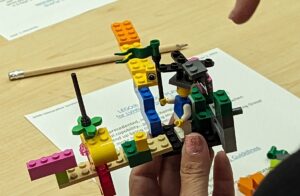In today’s remote and hybrid work environments, how do you maintain connection and camaraderie among employees? How do you strengthen team culture and reinforce the message “We’re all in this together?”
One of the best ways I found to do this is to bring people together in-person, in small groups of 6-10, to safely explore and share their experiences as team members in an immersive and impactful way. As a facilitator, I’ve witnessed the power of such an experience that builds better understanding among employees using LEGO® SERIOUS PLAY®.
Unlike the traditional approach of employees sitting around a table listening to a few colleagues while someone takes notes on a flipchart, LEGO® SERIOUS PLAY® enables 100% participant engagement and creative articulation of ideas. It engages small groups in individual and collective discovery as they build and share models using special LEGO bricks. And in its own unique way, it answers the question:
How can I know what I think till I see what I say?” (quote attributed to Graham Wallis and E.M. Forster)
What’s most gratifying is how participants are astonished by and appreciative of this shared experience that enables them to re-energize their feelings about work in a focused and fun way.
I love the following quotes which help illustrate the workplace benefits of a facilitated LEGO® SERIOUS PLAY® session:
Better understanding and alignment among team members
“You can discover more about a person in an hour of play than in a lifetime of conversation.” Attributed to Plato
“Leaping into the unknown when done alongside others causes the solid ground of trust to materialize beneath our feet.” Daniel Coyle, author of The Culture Code
Better collaboration and innovation
“Remote work makes it all too easy to default to ‘nothing but business’ mode. But genuine interaction, playfulness, and fun are important for collaboration and innovative thinking. You can always tell when teams are joyful in their work: The quality of the work is better.” Jenn Maer, former Design Director IDEO
“As well as providing much-needed stress relief … play can end up being counterintuitively, very productive. We can make interesting, new connections between ideas when we allow ourselves to loosen up from our regular goal-driven, laser-focused, instrumental approach.” Martin Reeves and Jack Fuller, Boston Consulting Group
Reinforced employee value and empowerment
“Fun is an exhale that people experience when they’re seen, valued, and empowered … we have to recognize that fun is the expression of lots of other important foundational investments in our team that enable people to show up whole, human, and valued.” Amber Naslund, LinkedIn Enterprise Sales Leader
“Shared understanding is what empowers us more than anything.” Chris Hadfield, Canadian astronaut
In our post-pandemic “next normal” world, employees need to re-connect in a memorable and meaningful way. Let me know when you’re ready to make this happen with LEGO® SERIOUS PLAY®.
You’ll be amazed at how well it plays out for you and your team.
[Image credit: Adithya Rajeev from Pixabay]



 As a LEGO® SERIOUS PLAY® facilitator, I find it gratifying to witness the group’s progress from their initial reactions about playing with LEGO® bricks at work -ranging from skepticism to amusement – to their full immersion in the process of shared understanding and unexpected joy in the process.
As a LEGO® SERIOUS PLAY® facilitator, I find it gratifying to witness the group’s progress from their initial reactions about playing with LEGO® bricks at work -ranging from skepticism to amusement – to their full immersion in the process of shared understanding and unexpected joy in the process.







